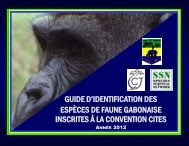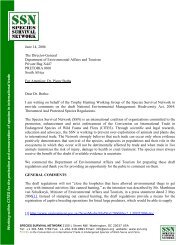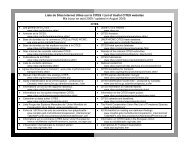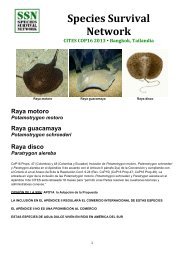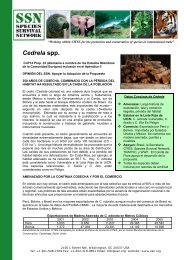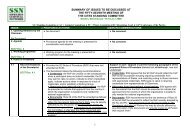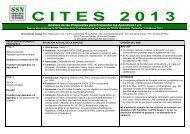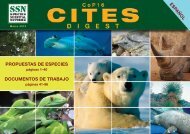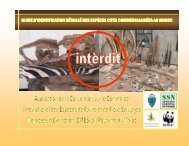CITES CoP16 Digest - Species Survival Network
CITES CoP16 Digest - Species Survival Network
CITES CoP16 Digest - Species Survival Network
Create successful ePaper yourself
Turn your PDF publications into a flip-book with our unique Google optimized e-Paper software.
DOCUMENT BACKGROUND / CURRENT STATUS EFFECT OF DOCUMENT SSN VIEW<br />
Continued<br />
··<br />
convene a workshop for Parties on the use of<br />
controlled deliveries (allowing illicit or suspect<br />
consignments to continue in transit with the<br />
knowledge and supervision of the authorities<br />
in order to identify the persons involved); and<br />
··<br />
report on progress at SC65 and SC66 and formulate<br />
recommendations as necessary; and<br />
• SC to review the report and recommendations of<br />
the Secretariat and determine whether any further<br />
actions are necessary.<br />
53.2.2 Report of<br />
TRAFFIC<br />
Cop16 Doc. 53.2.2<br />
• RC10.10 (Rev. CoP15), on Trade in elephant specimens,<br />
requests submission of a report to each CoP<br />
on data held in the Elephant Trade Information System<br />
(ETIS) managed and operated by TRAFFIC.<br />
• The objectives of ETIS are to:<br />
• measure and record levels and trends, and<br />
changes in levels and trends, of illegal hunting<br />
and trade in ivory in elephant range States, and in<br />
trade entrepôts;<br />
• assess whether and to what extent observed trends<br />
are related to changes in the listing of elephant<br />
populations in the <strong>CITES</strong> Appendices and/or the<br />
resumption of legal international trade in ivory;<br />
• establish an information base to support the making<br />
of decisions on appropriate management, protection<br />
and enforcement needs; and<br />
• build capacity in range States.<br />
• Prepared by TRAFFIC International.<br />
• Covers the period 1996 through 2011.<br />
• Notes that the rate of data submission to ETIS has<br />
increased since CoP15 but that participation by some<br />
countries remains poor.<br />
• Indicates that the amount of seized ivory has escalated<br />
since CoP15 and is currently at its highest level<br />
in the 16-year period examined by ETIS; states that<br />
that “elephants are facing the most serious conservation<br />
crisis since the 1989 trade ban was imposed<br />
under the Convention.”<br />
• Notes that investigation of large-scale seizures should<br />
be prioritized for follow-up attention by the Parties;<br />
currently, lack of forensic examination of source ivory,<br />
absence of itemized inventory lists of contents of<br />
seizures, and failure to conduct dedicated, long-term<br />
investigations along the entire trade chain results in<br />
very few arrests and convictions.<br />
• Concludes that:<br />
• “Thailand, Malaysia, the Philippines, Vietnam,<br />
Hong Kong SAR, South Africa, Kenya, Tanzania and<br />
China are the priorities of greatest concern in the<br />
illicit trade in ivory at the present time.”<br />
• Thailand and China are the most important enduse<br />
markets driving illegal ivory trade today, and<br />
any future decline in illicit trade will depend upon<br />
the actions taken by these countries.<br />
Continued<br />
• SSN urges Parties to take note of the findings in this<br />
report, which indicate the presence of a very serious<br />
elephant poaching crisis.<br />
• SSN strongly urges Parties to address the continuing flow<br />
of illegal ivory into China and Thailand, and China’s failure<br />
to control its legal ivory market.<br />
• SSN notes with concern that, with regard to China, the<br />
TRAFFIC report indicates that:<br />
• there has been an increase in ivory products being<br />
marketed outside of the regulated domestic ivory<br />
trade system;<br />
• a “significant deterioration in China’s domestic ivory<br />
trade control system” and government-accredited<br />
ivory trading retail outlets persistently selling ivory<br />
products without product identification certificates<br />
was reported at SC62 (SC62 Doc. 46.1); and<br />
• the failure of the “legal” ivory market in China has<br />
exacerbated the presence of illicit ivory products in<br />
the Chinese market, and that this "creates an opportunity<br />
for laundering products from illicit sources into<br />
the legal control system".<br />
• SSN notes with concern that, with regard to Thailand, the<br />
TRAFFIC report indicates that:<br />
• Thailand infrequently reports ivory seizure information<br />
to ETIS;<br />
• Thailand’s domestic ivory market is not in compliance<br />
with the requirements for internal ivory markets under<br />
RC 10.10;<br />
Continued<br />
www.ssn.org<br />
73



